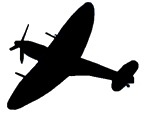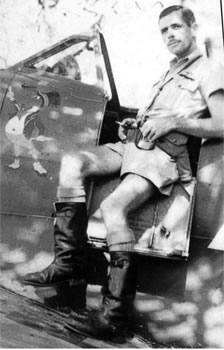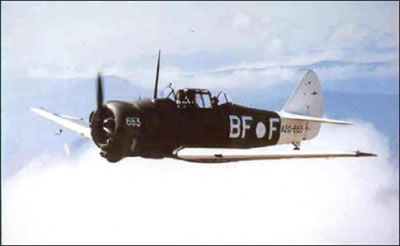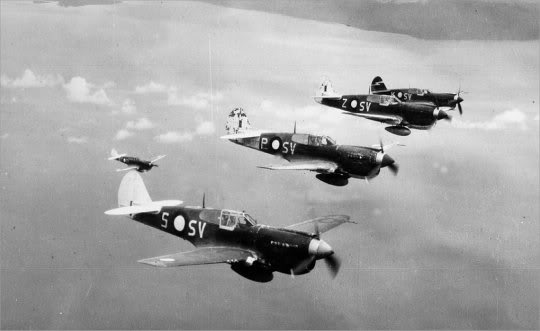The six Spitfires were ferried up to RAAF base Richmond where the wing had been formed. They were allocated two to each squadron, each of which also received two Wirraways and a Ryan ST-M trainer. This lack of aircraft was a major hindrance to training but the wing made the best of what it had. On 9 October, BR471, flown by Sergeant Michael Clifford of 452 Squadron crashed into the sea. This was the first Spitfire fatality in Australia, but the loss was also the pointer to a problem, which would cause the loss of more aircraft in the future.
The de Havilland constant-speed airscrew on the Spitfire VC suffered from oil leaks and had a propensity to overspeed, causing engine failure. This problem was never fully rectified and continued to plague the aircraft throughout its Australian service. Another Spitfire, (BR568), was damaged in a landing accident on the 27th, further reducing the aircraft available for training. The wing was desperately needed in the North, but until replacements for the aircraft repossessed by the RAF arrived, they lacked the feathers to fly.
The situation improved in October when three more ships arrived in Melbourne carrying a total of 64 Spitfires. These were quickly assembled at No. 1 Aircraft Depot, Laverton, and most were taken on the strength of No.1 Wing during November. The typical time from an aircraft arriving at No.1 AD, to its being delivered to No.1 Wing, was about three weeks, although some were delivered in about half this time. This was a minor miracle as it meant that the aircraft depot was assembling and checking out approximately two Spitfires a day. From this time, Spitfires arrived in Australia in a steady stream and it became possible to equip an Operational Training Unit and consider the establishment of yet another Spitfire Squadron. The RAAF would face no more problems with shortages of Spitfires.
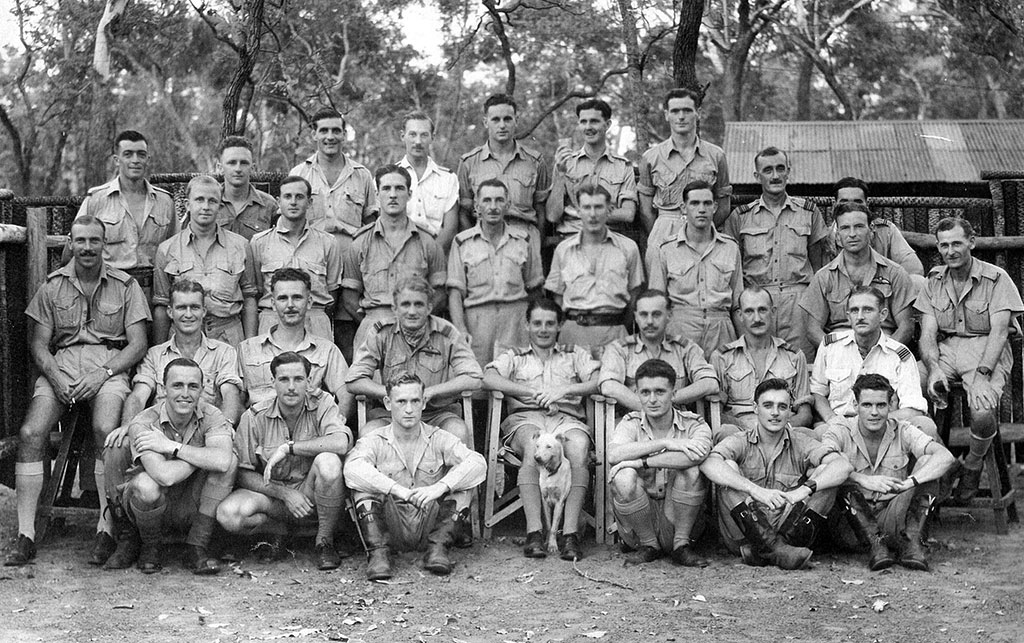
457 SQN Personnel
The six Spitfires were ferried up to RAAF base Richmond where the wing had been formed. They were allocated two to each squadron, each of which also received two Wirraways and a Ryan ST-M trainer. This lack of aircraft was a major hindrance to training but the wing made the best of what it had. On 9 October, BR471, flown by Sergeant Michael Clifford of 452 Squadron crashed into the sea. This was the first Spitfire fatality in Australia, but the loss was also the pointer to a problem, which would cause the loss of more aircraft in the future.
The de Havilland constant-speed airscrew on the Spitfire VC suffered from oil leaks and had a propensity to overspeed, causing engine failure. This problem was never fully rectified and continued to plague the aircraft throughout its Australian service. Another Spitfire, (BR568), was damaged in a landing accident on the 27th, further reducing the aircraft available for training. The wing was desperately needed in the North, but until replacements for the aircraft repossessed by the RAF arrived, they lacked the feathers to fly.
The situation improved in October when three more ships arrived in Melbourne carrying a total of 64 Spitfires. These were quickly assembled at No. 1 Aircraft Depot, Laverton, and most were taken on the strength of No.1 Wing during November. The typical time from an aircraft arriving at No.1 AD, to its being delivered to No.1 Wing, was about three weeks, although some were delivered in about half this time. This was a minor miracle as it meant that the aircraft depot was assembling and checking out approximately two Spitfires a day. From this time, Spitfires arrived in Australia in a steady stream and it became possible to equip an Operational Training Unit and consider the establishment of yet another Spitfire Squadron. The RAAF would face no more problems with shortages of Spitfires.
In early November No. 452 Sqn moved to Bankstown and No. 457 took up residence at Camden. This prevented congestion at Richmond, where No. 54 Sqn remained, but the three squadrons were still close enough to practice wing exercises. Throughout December training proceeded at a furious pace. To add even more workload it was found necessary to re-camouflage the Spitfires. These had been prepared for overseas service before dispatch to Australia. As well as fitting engine dust filters, pressurized fuel systems and other mechanical improvements, the aircraft had been painted in the RAF specified camouflage scheme for overseas service. This consisted of the RAF colours Dark Earth and Middlestone on the upper surfaces and Azure Blue on the under surfaces.
These colours were deemed unsuitable for service in Australia’s far North where the predominant colours were green and brown. It was decided that the lighter of the two upper surface colours, Middlestone, would be overpainted with the RAAF colour Foliage Green. This entailed extra work for the harassed ground crews.
The move North to the Wing’s new operational area commenced as the New Year dawned. It had been six months since the squadrons had left England and the pilots had done little flying. Many had not flown an operational sortie for over nine months, and the new boys had no operational flying at all, but now they were to move up to Darwin to protect that city and the surrounding military installations from Japanese air raids.
The ground crews were taken north by ship and the air echelon commenced its move in the middle of January. The route was Richmond – Mildura – Oodnadatta – Alice Springs – Daly Waters – to Batchelor Airstrip, some 90 km South of Darwin. The Australian Spitfire squadrons were forced to wait for a few days at Batchelor until Nos 76 and 77 Squadrons had cleared the area. No. 452 Squadron then moved into Strauss Airstrip, about 43 km South of Darwin, and 457 took up residence at Livingstone Airstrip 55 km South of Darwin on 31 January, 1943. No. 54 Squadron had proceeded directly to the RAAF Darwin Aerodrome. (Also known as Nightcliff).
On 2 February a Japanese ‘Dinah’ reconnaissance aircraft was reported approaching Darwin. Several Spitfires from No. 54 Squadron scrambled, and Flight Lieutenant Bob Foster dispatched it into the Timor Sea just off Melville Island. No.1 Fighter Wing had its first victory and the Japanese had been denied photos of the presence of the Spitfires. It was somewhat in vain however, as the next day another ‘Dinah’ flew over the area unmolested.

